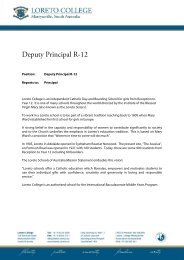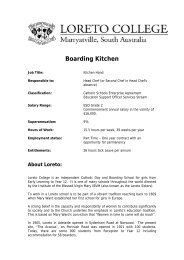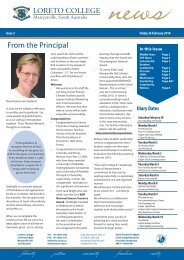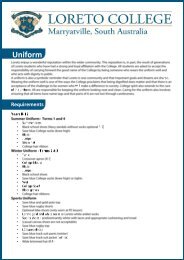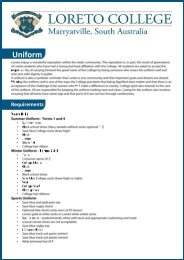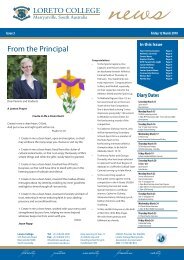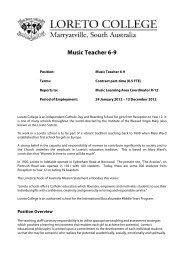IB learner profile booklet
IB learner profile booklet
IB learner profile booklet
Create successful ePaper yourself
Turn your PDF publications into a flip-book with our unique Google optimized e-Paper software.
<strong>IB</strong> <strong>learner</strong> <strong>profile</strong> <strong>booklet</strong>Introduction to the <strong>IB</strong> <strong>learner</strong> <strong>profile</strong>Nature of the <strong>IB</strong> <strong>learner</strong> <strong>profile</strong>The <strong>IB</strong> <strong>learner</strong> <strong>profile</strong> is the <strong>IB</strong>O mission statement translated into a set of learning outcomes for the 21stcentury. The attributes of the <strong>profile</strong> express the values inherent to the <strong>IB</strong> continuum of internationaleducation: these are values that should infuse all elements of the Primary Years Programme (PYP), MiddleYears Programme (MYP) and Diploma Programme and, therefore, the culture and ethos of all <strong>IB</strong> WorldSchools. The <strong>learner</strong> <strong>profile</strong> provides a long-term vision of education. It is a set of ideals that can inspire,motivate and focus the work of schools and teachers, uniting them in a common purpose.The <strong>IB</strong>O’s concept of an educational continuum, and of a coherent, broad-based international curriculum,was fully realized in 1997 with the introduction of the PYP. The <strong>IB</strong>O is now able to offer three programmes ofinternational education and, with them, the prospect of a continuous international educational experiencefrom early childhood to pre-university age. While the <strong>IB</strong>O now offers a sequence of three programmes—thePYP, the MYP (introduced in 1994) and the Diploma Programme (introduced in 1969)—each programmemust continue to be self-contained, since the <strong>IB</strong>O has no requirement for schools to offer more than oneprogramme. However, they must also form an articulated sequence for those schools that teach all threeprogrammes or any sequence of two.With the development of a continuum of international education, it is intended that teachers, students andparents will be able to draw confidently on a recognizable common educational framework, a consistentstructure of aims and values and an overarching concept of how to develop international-mindedness. The<strong>IB</strong> <strong>learner</strong> <strong>profile</strong> will be at the heart of this common framework, as a clear and concise statement of theaims and values of the <strong>IB</strong>O, and an embodiment of what the <strong>IB</strong>O means by “international-mindedness”.Aims of the <strong>IB</strong> <strong>learner</strong> <strong>profile</strong>The attributes and descriptors of the <strong>learner</strong> <strong>profile</strong> define the type of <strong>learner</strong> the <strong>IB</strong>O hopes to developthrough its programmes. It originated in the PYP where it was called the “PYP student <strong>profile</strong>”, butpractitioners from all three programmes identified it as a set of qualities that could also enhance learning inthe MYP and the Diploma Programme—learning that should not come to a stop at the age of 11, but shouldcarry through to the completion of the Diploma Programme. It is now called the “<strong>IB</strong> <strong>learner</strong> <strong>profile</strong>” to makeit applicable to all students and adults involved in the implementation of <strong>IB</strong> programmes, that is, to the <strong>IB</strong>Ocommunity of <strong>learner</strong>s.PYP curriculum documents describe the PYP student <strong>profile</strong> as “the common ground on which PYP schoolsstand, the essence of what they are about” (Making the PYP happen, 2000). This is a very clear statement ofthe importance of the <strong>profile</strong> to the programme. The <strong>IB</strong>O is introducing the <strong>learner</strong> <strong>profile</strong> into all threeprogrammes so that it becomes the common ground on which all <strong>IB</strong> World Schools stand, and contains theessence of what they, and the three programmes, are about.<strong>IB</strong> programmes promote the education of the whole person, emphasizing intellectual, personal,emotional and social growth through all domains of knowledge. By focusing on the dynamic combinationof knowledge, skills, independent critical and creative thought and international-mindedness, the <strong>IB</strong>Oespouses the principle of educating the whole person for a life of active, responsible citizenship. Underlyingthe three programmes is the concept of education of the whole person as a lifelong process. The <strong>learner</strong><strong>profile</strong> is a <strong>profile</strong> of the whole person as a lifelong <strong>learner</strong>.© International Baccalaureate Organization 2006 1





